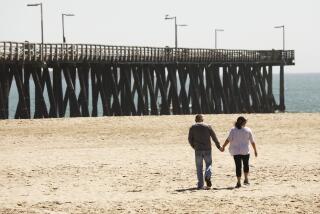Effects of Pipeline Spill Held Severe; Inquiry On
- Share via
A pipeline company responsible for a gasoline spill that forced the evacuation of about 1,500 Tustin Marines and their families last Nov. 22 is under investigation for possible negligence and could face fines or criminal charges, state and local officials said Wednesday.
The accident, which was up to 10 times worse than first reported, killed all wildlife for about two miles along a flood-control channel near the Marine Corps Helicopter Air Station in Tustin, according to Louis Courtois, a water quality biologist for the state Department of Fish and Game.
Early estimates placed the amount of unleaded gasoline that spilled from the burst pipeline into the tributary to Upper Newport Bay at 20,000 to 60,000 gallons, spokesmen for San Diego Pipeline Co. said at the time of the incident.
Up to 500,000 Gallons
But Courtois said Wednesday that an estimated 250,000 to 500,000 gallons of gasoline on its way from refineries in the Carson area to San Diego actually spewed out, killing frogs, fish, crayfish and birds below the pipeline break.
“We’ve got a severe loss of wildlife there,” Courtois said. “That in itself is enough for criminal charges.”
Four state and local agencies were expected to meet today to coordinate the investigation into the spill, said James R. Bennett, executive officer for the Santa Ana Regional Water Quality Control Board.
In the next several weeks, Bennett said, investigators for the water board, the Department of Fish and Game, the county Environmental Management Agency and the county Fire Department will examine the following issues:
- Whether the pipeline company was negligent in causing the spill.
- Whether the company balked at cleaning up the gasoline, contaminated water and soil in the spill’s aftermath.
- And whether the environmental damage could have been lessened if the company had acted differently.
On Wednesday, Bennett said: “The jury’s still out.”
Thomas C. Buckley, a pipeline company spokesman, said Wednesday that he was not worried about what would be revealed in an investigation.
“We will cooperate fully with any investigation,” Buckley said. “The important thing is that no one was injured. We’re concerned very much about the environment and birds. I wasn’t aware of any birds being killed. Our primary concern in a situation like this is people . . . and there were no injuries of any persons involved.”
Housing Evacuated
The gasoline leak was reported at 12:37 p.m. on Nov. 22. Nearby military housing was evacuated and streets in the surrounding area were closed soon after. The fuel apparently spewed from a three-foot gash along a weld in the 24-year-old pipe at Moulton Parkway, east of Red Hill Avenue in Tustin.
That same day, cleanup crews built two temporary dirt dikes in Peter’s Canyon Wash and San Diego Creek to keep the gasoline and fuel-contaminated water from flowing into the Upper Newport Bay state ecological reserve.
Early on Nov. 23, the pipeline was repaired, and those evacuated were allowed to return home. Soon after, the Irvine Ranch Water District released treated waste water into the channel to dilute whatever contaminants had escaped from the dams, Bennett said.
“It could have been a hell of a lot worse,” he said. “If gasoline had gotten into Newport Bay, we would have had a major ecological disaster in a sensitive ecological setting.”
Still, the damage was extensive, Courtois said.
“Downstream from the lowermost dam, we had a lot of fish killed,” he said. “For several days, we had no bird life at all in that area. . . . I walked the stream and noticed that in the downstream reaches toward Newport back bay, fish were heavily intoxicated. Like most wildlife, when you approach them they move off from your shadow. These were so intoxicated that I could reach down with my hand and pick them up.”
No one knows when the cleanup operation--which Buckley estimates will cost his company “several hundred thousand dollars”--will be complete. Although most of the gasoline is gone, contaminated soil and organic matter still must be removed.
“The cleanup process is still under way, but it is essentially completed,” Buckley said. “We are working with all of the environmental agencies to ensure that everything is under control and that there are no problems at all in terms of any further contamination.”
More to Read
Sign up for Essential California
The most important California stories and recommendations in your inbox every morning.
You may occasionally receive promotional content from the Los Angeles Times.













